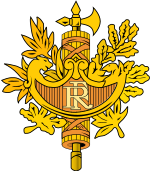French heraldry
| National Emblem of France | |
|---|---|
 |
|
| Details | |
| Armiger | The French Republic |
| Escutcheon | RF, standing for République française |
| Other elements | Fasces, laurel branch, oak branch |
French heraldry is the use of heraldic symbols in France. Although it had a considerable history, existing from the 11th century, such formality has largely died out in France, as far as regulated personal heraldry is concerned. Civic heraldry on the other hand remains a visible part of daily life.
The role of the herald (héraut) in France declined in the 17th century. Today the law recognises both assumed and inherited arms, considering them under law to be equivalent to a visual representation of a name, and given the same protections. However, there is no central registry of arms; in case of dispute, the individual who can prove the longest right to the blazon must be decided in court.
Many of the terms in international heraldry come from French.
Like the British system of heraldry, the French follow the Rule of Tinctures. This states that there are two types of Tinctures (heraldic colors): the colors Sable (black), Gules (red), Vert (green) and Azure (blue) and metals Or (gold or yellow) and Argent (silver or white). For sake of visibility (the whole point of the system), no Charges of a color can be used on a field of a color and no Charges of a metal can be used on a field of a metal, nor can the divisions of the field be color-on-color or metal-on-metal. Arms that do not follow the Rule of Tinctures are referred to as Armes pour enquérir (a "Coat of Arms to be investigated").
French heraldry has a set system of crown and coronets.Supporters are not linked with any rank or title, unlike the coronets, and are far less common than in other forms of European heraldry, such as English heraldry. Even the Royal Arms' angelic supporters are not shown in most depictions. Crests are rare in modern depictions, again in contrast to England.
The current emblem of France has been a symbol of France since 1953, although it does not have any legal status as an official coat of arms. It appears on the cover of French passports and was originally adopted by the French Foreign Ministry as a symbol for use by diplomatic and consular missions in 1912 using a design drawn up by the sculptor Jules-Clément Chaplain.
In 1953, France received a request from the United Nations for a copy of the national coat of arms to be displayed alongside the coats of arms of other member states in its assembly chamber. An interministerial commission requested Robert Louis (1902–1965), heraldic artist, to produce a version of the Chaplain design. This did not, however, constitute an adoption of an official coat of arms by the Republic.
...
Wikipedia
